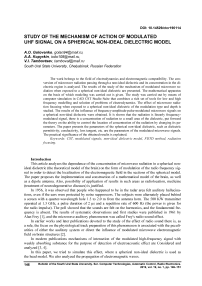Study of the mechanism of action of modulated UHF signal on a spherical non-ideal dielectric model
Автор: Golovenko A.O., Kopyrkin A.A., Tambovtsev V.I.
Рубрика: Краткие сообщения
Статья в выпуске: 1 т.19, 2019 года.
Бесплатный доступ
The work belongs to the field of electrodynamics and electromagnetic compatibility. The conversion of microwave radiation passing through a non-ideal dielectric and its concentration in the dielectric region is analyzed. The results of the study of the mechanism of modulated microwave radiation when exposed to a spherical non-ideal dielectric are presented. The mathematical apparatus on the basis of which modeling was carried out is given. The study was carried out by means of computer simulation in CAD CST Studio Suite that combines a rich set of tools for low and high frequency modelling and solution of problems of electrodynamics. The effect of microwave radiation focusing when exposed to a spherical non-ideal dielectric of the modulation type and depth is studied. The results of the influence of frequency-amplitude-pulse-modulated microwave signals on a spherical non-ideal dielectric were obtained. It is shown that the radiation is linearly frequency-modulated signal, there is a concentration of radiation to a small area of the dielectric, put forward the theory on the ability to control the location of concentration of the radiation by changing its parameters. The paper presents the parameters of the spherical non-ideal dielectric, such as dielectric permittivity, conductivity, loss tangent, etc. are the parameters of the modulated microwave signals. The practical significance of the obtained results is explained.
Cst, modulated signals, non-ideal dielectric model, fdtd method, radiation focusing, метод fdtd
Короткий адрес: https://sciup.org/147232230
IDR: 147232230 | УДК: 621.372.2 | DOI: 10.14529/ctcr190114
Текст научной статьи Study of the mechanism of action of modulated UHF signal on a spherical non-ideal dielectric model
This article analyzes the dependence of the concentration of microwave radiation in a spherical nonideal dielectric (the theoretical model of the brain) on the form of modulation of the radio frequency signal in order to detect the localization of the electromagnetic field in the sections of the spherical model. The paper proposes the implementation and construction of a mathematical model of the brain, as well as a dipole antenna. Also, possibility of application of results in such areas as radiolocation, medicine (treatment of neurodegenerative diseases) is justified.
In 1956, it was observed that people who happened to be in the radar area felt auditory hallucinations, even if the ears were protected by noise suppressors. The subjects were alternately placed behind a screen with a quarter-wavelength hole 1.5 to 2.0 m from the antenna horn. The 500 KW transmitter operated at 1.3 GHz, a pulse duration of 2 μs and a repetition rate of 600 Hz (the power is given for the radio impulse). The poll showed that the sounds are felt on the harmonics, and the fundamental frequency is absent. The results of systematic observations and first studies were published in 1961 by Alan Frey [1], and the microwave auditory phenomenon was called Frey's radio-sound effect.
In earlier works and later publications devoted to the study of the effect of radio sound there is, as a rule, the focus on the physiological track preparation of this phenomenon is associated with the peculiarities of either the auditory system or direct the influence of modulated microwave electromagnetic field on brain structures [2].
In modern publications mechanisms of interaction of the modulated high-frequency signal with weakly absorbing substance for the purpose of detection of electroacoustic effect are Considered and analyzed [3, 4].
In this paper, we tried to simulate this effect, where a spherical non-ideal dielectric is used as the head model. We also analyzed the propagation of electromagnetic waves.
In t h is p aper , a n u m er ica l s t udy of the interaction of electromagnetic radiatio n a n d t h e u se r' s h e ad w as c on d u c ted u sin g th e CST M icrowave Studio (CST MS) program. This pr o gram is based on th e F D TD m eth o d an d a llows f in d i n g a ll r eq uir ed fi eld ch ara cte r is t ics in the near and far zones. Since in th is s imu la ti on en vi r on m en t t he r e is an opportunity to produce the necessary ele c t r o d yn am ic cal cul a ti o ns u sin g t h e finite di ffere n ce m et h o d in the time d o m ai n.
B y s e l ec tin g d i ff e re nt t yp e s o f m o d u latio n an d i ts par a m eters, it is possible to provide the radiation co n c entr at i o n i n t h e n ecess ary re gion of the dielectric. A dipole antenna was used in the si m u lat i o n . It is w o rth no t i ng th a t w ith deviatio n of the frequency of the chirp signal of less than 10 %, th e ho rn ante nna ca n b e r ep l ace d w ith a vi br atory a ntenna, as was done in the study to increase th e c a l c ul a ti on s p e e d . As a model of a non-i d e a l d i el ectr ic, a spherical model of the brain (the average si z e) w a s cho sen f or r es e a r ch [5 , 6] . Thi s i s a si mp li f i e d m o d el, c onsisting of skin and bone layers and the brain itself. This mode l mak e s it poss ibl e t o v i sua l ly examine the mechanism of the action of the emitte d m i c r owa v e sig nal.
Th e fo llo win g f o rm u las n e ces sary for our calculations are derived from Maxwell's b asi c equations d is co ve r ed and p r o ved b y h i m a t t h e begin n in g o f th e ni n e teen t h c en t u ry [7 ] .
Th e final eq ua tio n s of t h e e lec tro m agn e t ic fi el d for a sp her ica l n o n-ideal dielectric (1), (2), obtained f ro m M ax w ell's e q u atio ns , it l oo ks like th is:
h x ( I , j , к ) ( n + 1)
I X'
= H o ( I , J , K ) n e V ц7
+
( ( a t U
I X + I1-eV ц7
( 1
I n +—
- ( - h x ( I , j , к ) V 2
— Н-Ц. H X ( I , J , к ) V n 2 J о
—
V J
— ( Ez 7 ( I , J + 1 , K ) n + 2 1 J ,E X ( I , J , K ) --------+ E ° ( I , J , K + I) n + 2 1 J —
( о Y o ( J + 1) — У о ( J )) y
( 1 7
I n +I
( E X ( I , J , K ) V 2 J ))
;
о ( Z o ( K + 1) — Z 0 ( K ) )
( 17 ( At) ( ( At )7
I n +t I X 1 I I — ° +— I
E X ( I , J , K ) ( n + 1) = E X ( I , J , K ) V 2 J e V " J+ 1 — e V " J— E X ( I , J , K ) n --^0 E X ( I , J , K ) n +
о
V J
+ ( h x ( I , j , k ) n
H X ( I , J — 1, k ) n x * ( Y ( J ) — Y ( J — 1)
— ( H y X ( I , J , K ) n
Ho o ( I , J , K — 1) n ( o *( Z ( K ) — Z ( K — 1)),
where H – t h e vec to r o f t he m agn eti c fie ld str en gt h; E – the electric field strength vector; I , J , K , x , y – are the spatial coordinates; e, ц - di e lec tr ic a n d magnetic permeability of the medium.
In t h e t heo r et i c a l a s p ect , w e h ave a circular waveguide, in which, during the pas s a ge o f a mo nochromatic signal, the E 11 wave con centr at i o n occur s a c co r di n g to Fig. 1 [8 ].

Fig. 1. Distribution of the wave E 11 in a circular waveguide
B y ch o o si n g d if f er e n t m o d u l a tion types and parameters, it is possible to pro vid e c o n c en t ra ti on of th e r adiatio n in th e des i re d r egi o n of the dielectric. Dipole antenna was used for m o d eli n g. I t is worth n o tin g t hat w hen the f r eq ue n cy d eviation of the LFM signal less than 10% horn ante n na can b e rep l ace d b y a vi b r at or , as was d o ne in t h e st ud y t o i nc re a s e t h e c alcula t ion s p e ed .
As a model of non- i d e al di el ec tr ic, a sp her ica l m o d el o f t h e br a i n ( average size) was chosen for th e r ese ar ch. T h i s i s a simp lif i ed m odel consisting of the skin and bone layers and t h e b r a i n i t s e lf. T h is m o d el all ow s yo u t o vi sual ly ex amine the mechanism of action of the emitted micro wave s ign al.
We present the simulation results when radiation is a monochromatic signal, shown in Fig. 2, 3 and LFM signal, in the Fig. 4, 5.
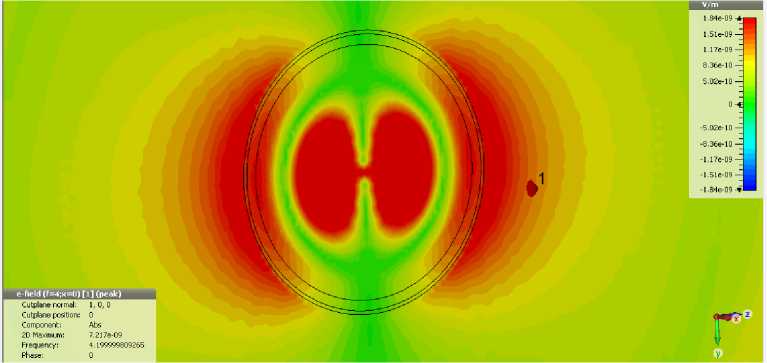
Fig. 2. Field strength in the vertical plane when a monochromatic signal is emitted
In the course of the simulation, we obtained that when the unmodulated signal is emitted, the concentration of the electromagnetic field in the dielectric resembles the concentration of the E 11 wave in a circular waveguide [8].
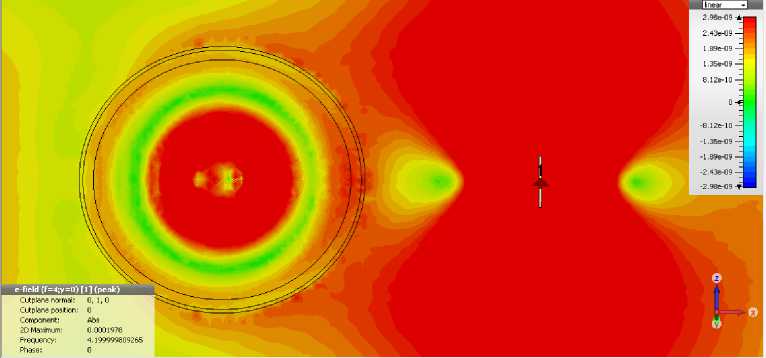
Fig. 3. Field strength in the horizontal plane when a monochromatic signal is emitted
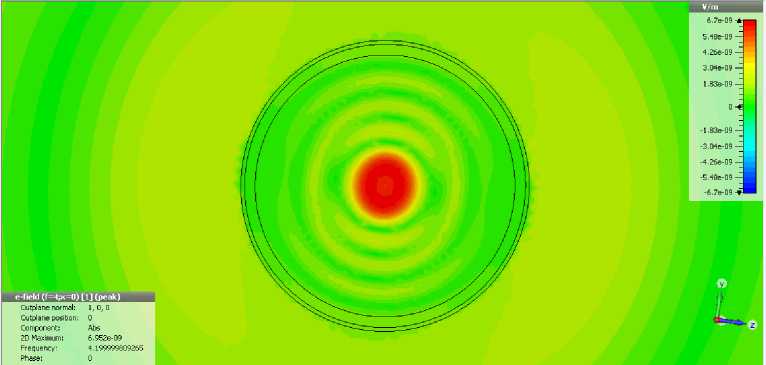
Fig. 4. Field strength in the vertical plane during the emission of the LFM signal
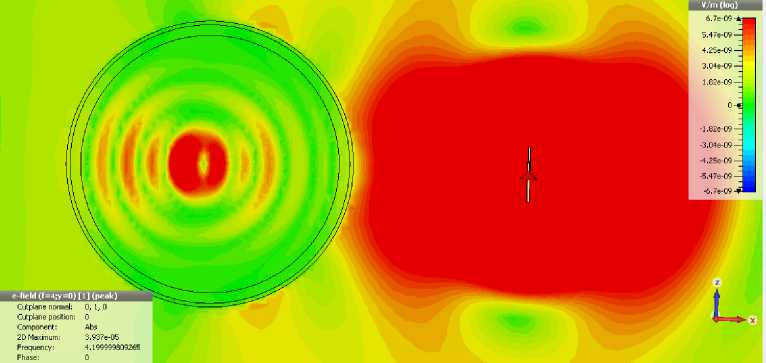
Fig. 5. Field strength in the horizontal plane during the emission of the LFM signal
The human head as a biological body has a rather complex structure and consists of several types of biological tissue with losses, in which the power is absorbed unevenly because of the difference in the conductivity of each layer. Therefore, an accurate construction of the head model is an important condition for the accuracy of the calculation of the internal field [9]. The averaged values of the main parameters of the frequently used three-layer model of the human head are presented in Table 1.
The parameters of the three-layer model of the human head
Table 1
|
Substance |
Thickness, mm |
Relative dielectric permittivity, GHz |
Сonductivity of the layer, Sm/m |
The density of layers, kg/m3 |
Thermal conductivity, W/K/m |
|
Brain |
fill |
53 |
1.1 |
1030 |
0.3 |
|
Bone |
3 |
9 |
0.06 |
1800 |
0.01 |
|
Skin |
1 |
59 |
1.3 |
1100 |
0.5 |
The following conclusions can be drawn from the results obtained. The LFM signal is focused primarily at the center of the dielectric, in the horizontal plane there are side regions of radiation concentration in the form of circles, the distance between which depends on the frequency of deviation.
It must also be taken into account that the voltage of the source operating at the antenna input varies with time. Therefore, for each time step, it is necessary to calculate the values of the electric and magnetic fields at all points of the analyzed space, in accordance with the time domain method (FDTD method).
The use of the FDTD method is particularly advantageous in the study of non-stationary processes – for example, the electromagnetic field of antennas when excited by short pulses or modulated signals.
This study will help in predicting the treatment of such diseases in which it is necessary to affect specific areas of the brain. In radar, when studying the wobbling of a modulated signal on a spherical object.
Further research will consist in the complication of the model, the use of a horn antenna and a phased array, the use of a supercomputer.
Список литературы Study of the mechanism of action of modulated UHF signal on a spherical non-ideal dielectric model
- Frey, Allan. Auditory system response to radio frequency energy / Allan Frey // Aerospace Med. - 1961. - 32. - P. 1140-1142.
- Elder, J.A. Auditory Response to Pulsed Radiofrequency Energy / J.A. Elder, C.K. Chou // Bioelectromagnetics. - 2003. - 24. - P. 162-173. DOI: 10.1002/bem.10163
- Higdon, R.L. Absorbing boundary conditions for difference approximations to the multi-dimensional wave equation / R.L. Higdon // Math. Comp. - 1986. - Vol. 47. - P. 437-459. DOI: 10.2307/2008166
- Баринов, А.Е. Коагуляция частиц крови под воздействием СВЧ излучения / А.Е. Баринов, В.И. Тамбовцев, Д.А. Кыдырбаева // Материалы XIII Международной конференции «Физика и технические приложения волновых процессов». - Казань; Самара, 2015. - С. 353-355.
- Budden, K.G. The Waveguide Mode Theory of Wave Propagation / K.G. Budden. - London: Logos Press, 1961. - 325 p.
- Terman, F.E. Electronic and Radio Engineering / F.E. Terman. - New York: McGraw-Hill Book Company, 1955. - 1078 p.
- Kunz, K. The Finite Difference Time Domain for Electromagnetics / K. Kunz, R. Luebbers. - 1993. - P. 90-91. DOI: 10.1201/9780203736708
- Семенов, Н.А. Техническая электродинамика: учеб. для вузов / Н.А. Семенов. - М., 1973. - 480 с.
- IEEE C95.1-1991, IEEE Standard for Safety Levels with Respect to Human Exposure to Radio Frequency Electromagnetic Fields, 3 kHz to 300 GHz. - New York: The Institute of Electrical and Electronics Engineers, Inc., 1992. - https://standards.ieee.org/standard/C95_1-1991.html.

